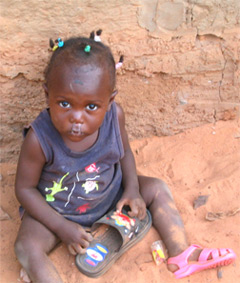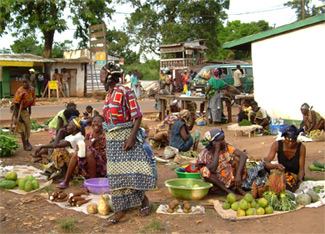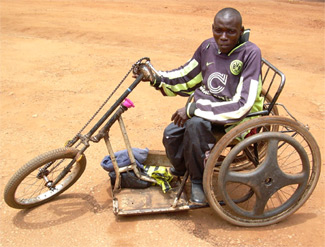|
|
Luanda, the capital of Angola, was founded by the Portuguese in 1575. In the beginning, Luanda was principally a port serving Portuguese navigators in their commercial activities for West Africa. It was also a point of departure on the long road to India. At that time, the city was referred to as “La route des épices” (“The road of spices”). Luanda was also a factory centre for Portuguese enterprises. Located on the West coast on the Atlantic Ocean, today Luanda is the largest city of Angola and also the principal port of the country.
Since the peace accord was signed between UNITA (Independência Total de Angola) and MPLA (Popular de Libertacão de Angola) in April 2002, Angola has been in constant transformation and rebuilding. Thousands of Angolan refugees in neighbouring countries are returning home and villages are returning to normal, despite the presence of land mines.
A Big Challenge—The Cities of Angola
One of the biggest challenges for Angola is its cities, particularly the capital. Like the majority of countries in the Southern Hemisphere, Angola is very urban. Best estimates show that Luanda has a population of more than five million inhabitants, representing forty percent of the total population of a country of fourteen million people. If we add this to the population of other major Angolan cities (Lobito, Benguela, Huambo, Lubango or Namibe), we see that more than seventy percent of Angola lives in these cities. ![]()
After nearly thirty years of civil war (1975-2002), practically all urban infrastructure has been destroyed. Angola’s government is making an incredible effort to rebuild the country; because of this, Luanda has become a large construction site. However, one cannot remove the consequences of war—including exorbitant prices of accommodation and essential goods—in a short period of time. Today, Luanda one is of the most expensive cities in Africa. Criminality is also creating an increasingly insecure atmosphere in the city.
|
|
A Bigger Challenge—The Shantytowns of Luanda
The biggest challenge in these cities is the shantytowns, known here as musseques. Unhealthy conditions, promiscuity and injustice are daily concerns in these areas. Add to this the enormous health concerns of musseques dwellers, sometimes brought on by a very high level of unemployment. Even if the government reports that cholera and the AIDS epidemic are under control, the reality is that numerous deaths are registered each day.
In Luanda, one-quarter of the households have per capita consumptions of less than seventy-five US cents per day. Child mortality in Luanda is 320 per one thousand; compare this to Canada, where it is five per one thousand! The poor in the musseques are abandoned; the state spends only one percent of its budget on public education and welfare. Many people in these communities spend up to fifteen percent of their revenue just to purchase water.
The Church’s Role in the Musseques
Contrasts are visible in Luanda. It is frequent to see great luxury and ostentation alongside extreme poverty. Big churches, many of them built during the colonial period, are often located in these slum and disadvantaged neighbourhoods. Are these structures contextualised for the present situation? Do the parishioners really understanding the needs and suffering of the people? Are they prepared or trained to face the issues their parishioners have?
The answer to these questions, unfortunately, is no. They are not prepared and trained to face these issues, and for most of them, providing “good training” or a “good biblical approach” means either (1) perpetuating a classical way to be the Church with heavy liturgies or (2) having a charismatic celebration with an emphasis on prosperity. Contextualisation is unknown to most of them. The majority of the leaders of these churches are not living in musseques or in the neighbourhoods of the parish.
In the context of this article, then, the question we need to ask ourselves is: What are the churches doing to help the people of Luanda and in particular, the shantytowns? Before answering this question, it is important to mention two important historical issues the Angolan Church and population must face which make it difficult for a change of mentality and approach. The first is political; the second is religious or missiological.![]()
During the civil war and in a Marxist political context, some churches were closed and others were limited to Sunday services only. Shantytowns were left to themselves; some rare churches celebrated on Sundays without any access to resources. Although the missiological legacy is different, it is also important. In the past, missionary activities were concentrated on the interior of the country, particularly in rural areas. Today, with a majority of the population living in cities and in the context of the consequences of war, the impact of this mission legacy on the quality of life of Angolans is limited. Some mission societies are still open, concentrating their activities in health care.
|
|
The Future of the People and the Church in the Musseques
Returning to our question, the portrait is bleak. With the new liberties and free expression Angola is experiencing, classical churches have become even more traditional in an effort to try and protect themselves against an invasion of new sects and spiritualities. Angola lives on a wave of syncretism, where new sects obtain fast profit and growth. The most visible is a sect coming from Brazil, which has a very strong emphasis on a theology of prosperity. This sect is omnipresent in the shantytowns of Luanda. Twenty-four-hour church services proclaiming instant prosperity and delivery from poverty are the norm. Classical churches preach a gospel of resignation; therefore, it is not difficult to understand why these new sects have grown so quickly.
And yet we cannot say the churches in the shantytowns of Luanda have done nothing. However, their actions are like drops in the ocean of needs and dilemmas these people are facing. Still, the reality is, the Church can do so much more. Here are three steps the Church can take:
- Overcome the classicism of ancient programs and mentalities
- Offer church leaders contextualized training in urban ministries
- Help church leaders develop their own solutions instead of waiting for outside help
Angola, and in this particular case, Luanda’s shantytowns, need our prayers and aid. The best way to help the Angolan people is to provide biblical contextualised training to church leaders and a new hermeneutic of reading the Bible. Angola has several Bible schools with good programs in Bible classic studies; however, often these do not include practical application for church dilemmas or urban ministry approaches.
Indeed, the shantytowns in Luanda are enormous fields and opportunities for the global Church. However, the Church in Angola needs help and prayer to shift from the classic paradigm to one that is more contextualised and closer to the people.



